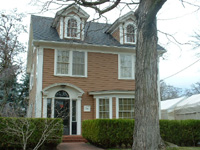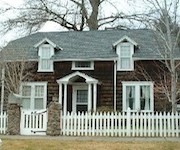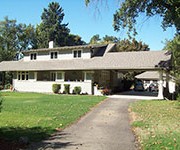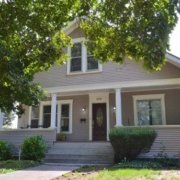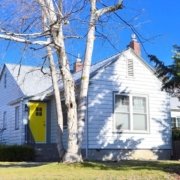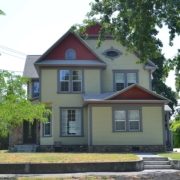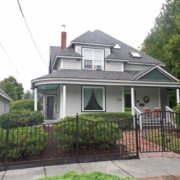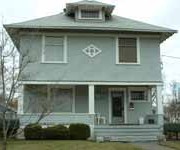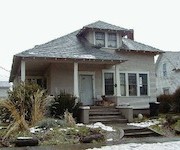History of 244 Marcus Street, Walla Walla, WA
Legal Description
Original Tract:
Beginning at a point in the East line of Lot 6 in Block 2 of Boyer Grove
Addition to the City of Walla Walla, according to the official plat thereof
of record in the office of the Auditor of Walla Walla County, Washington, in
Book C of Plats at page 13, which point is 32.5 feet North, measure along
said line East, from the Southeast corner of said Lot, and running thence
South 89′ -39′ West, parallel to the South line of said Lot, a
distance of 77 feet; thence South 00′ -22′ East 6.5 feet; thence South 78′
-25′ -30′ West 70.6 feet to a point in the West line of said Lot, in
which point is 12.07 feet North, measured along said West line from the
Southwest corner of said Lot; thence North 00′ -22′ West, along said West
line, 37.63 feet to the Northwest corner of said Lot; thence North 75′ -18′
East along the North line of said Lot, 150.7 feet to the Northeast corner of
said Lot; thence South 00′ -22′ East along said East line , 47.5 feet to the
point of beginning
Tract 1 added:
Beginning at a point in the East line of Lot 6 in Block 2 of Boyer Grove
Addition to the City of Walla Walla, according to the official plat thereof
of record in the office of the Auditior of Walla Walla County, Washington,
in Book C of Plats at page 13, which point is 32.50 feet North, measured
along said East line, from the Southeast corner of said Lot, and running
thence S 89′ -38′ -00 W, parallel to the South line of said Lot, a
distance of 77.00 feet; thence S 0′ -22′ -00 E, 6.50 feet;
thence S78′ -25′-30′ W, 70.34 feet to a point in the West line of said Lot,
which point is 12.32 feet North, measured along said West line from the
Southwest Corner of said Lot, thence S0′ -22′ -00 E, along said West line,
4.09 feet to a point which is 8.23 feet North measured along said West line
from the Southwest Corner of said Lot; thence leaving said Line and run N79′
-31′-55′ E. a distance of 18.81 feet; thence S89′ -08′ -13’E, a distance of
127.50 to a point in the East line of said Lot; which point is 8.80 feet
North measured along said East line from the Southeast Corner of said Lot;
Thence N 0′ -22′ -00′ W, along said East line a distance of 23.70 feet pt
the Point of Beginning. Containing 2,345 sq. ft.
Title History
The land that comprises the City of Walla Walla was acquired from the
Cayuse and Walla Walla Indian tribes by the U.S. Government with a treaty
signed on June 9, 1855 in Walla Walla and ratified on March 8, 1859 by
President James Buchanan. Walla Walla was originally laid out by
surveyor H.H. Case in 1859, even before its formal incorporation as a city
in 1862, as a one-quarter mile square oriented N-S, E-W with its eastern
side centered on the point where Main Street crossed Mill Creek (roughly at
the point where it does now). To this original area, additional
parcels were annexed from time to time.
The first recorded transaction for the land where the Blynn house stands
was by an Act of Congress, approved March 3, 1855 granting Bounty Land to
certain officers and soldiers. Therefore, a General Land Office
Warrant No. 88771 for 160 acres was granted to Cornelius Kelly, sergeant,
Company F, 3rd Regiment, U.S. Artillery, California Indian War.
Mr. Kelly sold the land to Andrew J. Cain September 10, 1862.
Mr. Cain sold the land to Dorsey Baker December 20, 1871.
Mr. Baker sold the land to John Feral Boyer March 30, 1896.
The Dorsey Baker Estate and the John F. Boyer Estate created the
Boyer Grove Addition February 10, 1899. The plat was bounded by Mill
Creek to the North, Palouse Street to the West, Park Street to the East and
Alder Street to the South.
Lot 6 Block 2 of the Boyer Grove Addition was deeded from the John F.
Boyer estate to Sarah Boyer, his widow, April 18, 1903. At that time,
Mrs. Boyer deeded the lot to her son, Eugene Boyer.
Mr. Eugene Boyer deeded Lot 6 to Arthur Boyer October 14, 1903.
Mr. Arthur Boyer sold the lot to James Sauze for 630 gold coins December
28, 1903. James lived at 264 Marcus where he had a tinsmithing shop at the
rear of his house.
James and Jane Sauze sold Lot 6 to Harriet E. Blynn, a widow, for $1200
March 2, 1906.
Harriet Blynn gifted the home to her daughter Katharine Blynn, spinster,
with love and affection May 24, 1909.
Katharine Blynn sold the house to Lorena Stanton, a widow, for $6000
November 11, 1954. Mrs. Stanton owned and lived in the house next door
at 248 Marcus St.
Lorena Stanton sold the home to Howard M. Tomlinson for $7500 February
28, 1955. He was a construction superintendent in Alaska while his
wife owned Ray Cleaners.
Howard and Myrtle Tomlinson passed the home to Dale Leon Hopson as a gift
April 2, 1969. Mr. Hopson operated the Chevron station in
Milton-Freewater, OR.
Dale Hopson sold the home to George J. Drumheller for $21,000 January 3,
1975. Mr. Drumheller used the property to house his business, George
Drumheller Properties.
The Drumheller Estate sold the property at a closed bid auction to
William and Bonnie Szuch for $124,849 December 1, 2000.
Miss Blynn’s home was probably built in 1906-07. The city directory
shows Harriet and Katharine living at 244 Marcus in 1908. Miss Blynn
was a graduate of Indiana University, Class of 1893, a member of Kappa Alpha
Theta. Miss Blynn was one of the first students in the Stanford
University Graduate School in 1902. Miss Blynn was a teacher for 61
years. She headed the Walla Walla High School math department for 32
years. She was awarded an honorary Masters of Arts degree by Whitman
College in 1925. She moved to Walla Walla and in 1905, was living in
Prentiss Hall on the Whitman College campus. Her mother, Harriet, a
widow, arrived in 1907. Miss Blynn was active in community affairs.
She was instrumental in initiating the Camp Fire movement in Walla Walla and
served as president of Walla Walla Art Club. Her brother-in-law,
Edward E. Rubey, was a former dean of Whitman College.
Miss Blynn’s home was opened each Spring and Christmas for formal teas.
Walla Walla residents remember being delighted by the fireplaces and excited
to add a chemical to the fire to create sparkles during the Christmas tea.
Rooms were let to students on the third floor of the home. During the years
after her passing, the home was a rental. When Mr. Tomlinson bought
the house, he created an apartment with exterior wooden stairs leading to
the second floor.
From Walla Walla – Her Historic Homes, we excerpt information prepared by
George Drumheller and included by author Penny Andres.
“Before flood control, Mill Creek nearly floated the house off its
foundation several times which resulted in severe settling. After Miss
Blynn’s departure from the place in the early 1950s, the ravages of time,
accelerated by abuse, brought the structure to a state where few people
could see anything worth restoring.
Construction was typical of a 1900 home with softwoods throughout, in
this case redwood, now a costly material which Miss Blynn’s nephew informed
us was preferred by her. Surprisingly, the completed dwelling cost
less than $1000. Most homes in the Greek Revival style of this area
are much larger, the products of bigger budgets and appear with elaborate
hardwoods, oak in particular, from the staff’s basement work areas to the
third floor halls.
The Blynn House parlor and dining room are excellent examples of what
was that day’s popular design: massive wainscoting and dentil with
out-of-balance fireplaces, the work of stylists Eastlake and Morris.
The off-center entrance with its elliptical arch, supported by
decorative pilasters, has a semi-circular fan light and side lights.
The triple-windowed bay with its balustrade and the Palladian window on
third floor windows facing north, east and south, are special classical
features.
This house is a wonderful example of what careful restoration can
accomplish.”
George Drumheller purchased the Blynn home after if had become quite
deteriorated. He determined to return the house to its original state.
He removed the outside stairs and the apartment. He hired craftsman to
duplicate missing moldings and a master painter from Portland to faux paint
the distressed fir stairs and the first floor mantels, wainscoting and trim
moldings. He planted trees and shrubs on the grounds.
Miss Blynn’s home is again a single family dwelling. A 2300 square
foot parcel was purchased from the First Congregational Church to allow
space for gardens to the south of the home. The Szuchs are slowly
replastering and painting. The numerous six over six windows are still
original and some have been renovated with old wavy glass. During the third
floor renovation, the Szuch’s found a signature of I.H. Carmichael on the
inside of a door frame. Mr. Isaac Carmichael of 720 N. Main was one of
the best known contractors in the city, according to his obituary notice.
Walla Walla was his home from 1903 until his death, suddenly at 67, from a
ruptured blood vessel on July 17, 1912.
A picture of Miss Blynn graces the foyer as a reminder to all who enter
of her legacy.

